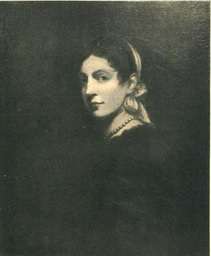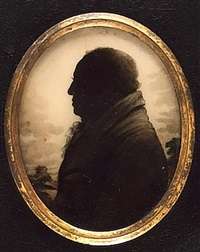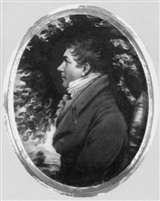Jane Beetham Read
Jane Beetham Read (c. 1773 – 16 January 1857) was an English portrait painter who began by working in her mother, Isabella Beetham's studio painting silhouette portraits in the 1790s. She studied under John Opie and exhibited her works at the Royal Academy of Arts between 1794 and 1797.
Jane Read | |
|---|---|
 John Opie, Jane Beetham, 1790–1800, Brompton Consumption Hospital collection | |
| Born | Jane Beetham c. 1773 London |
| Died | 16 January 1857 London, England |
| Nationality | British |
| Education | |
| Known for | Silhouette and miniature portraits |
| Spouse(s) | John Read |
Early life
Jane Beetham was born about 1773 to Edward and Isabella Beetham.[1] She was the granddaughter of William Betham of Little Strickland in Cumbria, England.[2] Mary Matilda Betham was her cousin.[2]
Jane was the first of six children.[1][3] Her brother, William was born in 1774. Her other siblings were Harriet, Charles, Cecilia, and Alfred.[3] The Beethams first lived in Cow Lane, Clerkenwell, London and then Little Queen Street, Holborn, London.[3] They moved to 26 and 27 Fleet Street in 1785. Her mother operated a silhouette portrait studio and her father sold his patented washing machines in the buildings that housed their residence.[4]
Education and career

Read painted portraits from the 1790s until 1815.[5] She painted silhouettes, generally on glass, for her mother from the early 1790s until 1797.[6][7] Read's work was influenced by her mother's style and was often framed in pearwood or papier-mache.[5] Her name (Miss Beetham) appeared on the sixth of seven trade labels issued by Isabella's business. The sixth label was used in the 1790s.[3] In the late 1790s, Jane developed her own business with her own trade label. She added brass or ormolu frames as her career progressed.[5]

She studied painting under John Opie and was the only female student that he taught.[2] He painted her portrait between 1790 and 1800.[8][9]:106[lower-alpha 1] Using a painting made by Opie, Read painted a portrait of Dr. Priestly.[3] They may have had a romantic relationship.[5] It was a concern of her uncle, Rev. William Betham (1749–1839) who warned Isabella about Jane and Opie spending too much time together. His comments soured William's relationship with the Beetham's.[9]:105 Opie's wife, the former Mary Bunn, ran off with another man and the Opies were divorced on 23 December 1796.[9]:108–110 Opie was adamantly rejected when he asked Edward Beetham if he could marry Jane. Soon after, Jane married John Read.[9]:112
As she began painting miniature portraits, she developed her own personal style. She often framed sitter's faces with dark foliage of landscaped backgrounds. She used a combination of techniques to depict bone structure, used stippling and hatching to capture the subject's features, and used a combination of thick and thin paint brush strokes. Her tools included two sizes of needles, for details, and two sizes of brushes.[5] Read also created works using her own aquatint method.[8]
..jpg)
Read exhibited portraits at the Royal Academy of Arts for four consecutive years, from 1794 to 1797.[2][10] A total of 15 paintings were shown,[9]:112[lower-alpha 2] including Cordelia Angelica Read, A Lady Reading a Letter, Andromeda, Eloisa, and King Lear and Cordelia.[2]
Personal life
She married John Read, a solicitor from London around 1797[5] or in 1798.[2] He was much older, wealthy, and eccentric.[9]:112 They had a daughter, Cordelia Angelica Read[2] and lived on Lamb's Conduit Street. Jane's father died in 1809 and his estate was divided equally amongst her mother and the six Beetham children.[3]
John died in 1847. Jane and Cordelia, known as the "old sisters" for their eccentric behavior, lived together in Stamford Street, London. The house was suggested to be haunted, according to newspaper articles.[5] Cordelia remained single her entire life.[9]:112
Jane died in London on 16 January 1857.[5] Upon her death in December 1871,[12] Cordelia left her mother's pictures and a legacy of £100,000 (equivalent to $9,379,739 in 2019) to the Brompton Consumption Hospital,[2][13] which was used to build an extension to the hospital. A memorial slab was laid in her honor under a central window.[13] The hospital also received the Read's art collection which included a number of paintings by Opie and by Beetham. Cordelia had lived as if she was destitute and was negligent in the care of material items. Many of the paintings needed to be refurbished and preserved, which was funded by selling off some of the paintings. The hospital kept the paintings that Opie painted of his mother, Jane, and her sisters Cecelia and Harriet. They sold the painting of Mary Betham Bligh, Admiral William Bligh's wife; The Card Players; and a self-portrait. Another £100,000 was given to a relative in accordance with Cordelia's will.[9]:113
Notes
- The portrait, which depicted her in a dark dress, with a light blue scarf covering her head, and against a black background, was bequeathed to the Brompton Consumption Hospital in 1871.[8]
- Other exhibitions, from 1804 to 1815 were attributed to Jane,[10] but were really shows of work of her cousin Mary Matilda Betham.[11] It was said that she had the most exhibitions, nearly 20, of the silhouette artists in Britain,[5] but there has been a miscalculation due to the confusion with the submissions by her cousin.[11]
References
- "Mrs. Isabella Beetham". Profiles of the Past (The Brunswick Town Charitable Trust, The Regency Town House Heritage Centre, and the Silhouette Collectors Club). Retrieved 3 March 2015.
- Sara Gray (2009). The Dictionary of British Women Artists. Casemate Publishers. p. 35. ISBN 978-0-7188-3084-7.
- "Mrs. Isabella Beetham - Section 3". Profiles of the Past (The Brunswick Town Charitable Trust, The Regency Town House Heritage Centre, and the Silhouette Collectors Club). Retrieved 3 March 2015.
- "Mrs. Isabella Beetham - Section 1". Profiles of the Past (The Brunswick Town Charitable Trust, The Regency Town House Heritage Centre, and the Silhouette Collectors Club). Retrieved 3 March 2015.
- "Jane Read". Profiles of the Past (The Brunswick Town Charitable Trust, The Regency Town House Heritage Centre, and the Silhouette Collectors Club). Retrieved 4 March 2015.
- Joy Ruskin Hanes. "Shady Ladies: Female Silhouette Artists of the 18th Century". New England Antiques Journal. Palmer, Massachusetts. Archived from the original on 4 July 2009. Retrieved 3 March 2015.
- "Mrs. Isabella Beetham - Section 2". Profiles of the Past (The Brunswick Town Charitable Trust, The Regency Town House Heritage Centre, and the Silhouette Collectors Club). Retrieved 3 March 2015.
- John Jope Rogers (1878). Opie and His Works: Being a Catalogue of 760 Pictures by John Opie, R.A., Preceded by a Biographical Sketch. P. and D. Colnaghi and Company. pp. 151–152.
- Ada Earland (1911). John Opie and His Circle. London: Hutchinson & Company. Retrieved 3 March 2015 – via OpenLibrary.
- Algernon Graves (1905). The Royal Academy of Arts: A Complete Dictionary of Contributors and Their Work from Its Foundation in 1769 to 1904. H. Graves and Company, Limited. p. 165.
- Algernon Graves (1906). The Royal Academy of Arts: A Complete Dictionary of Contributors and Their Work from Its Foundation in 1769 to 1904. H. Graves and Company, Limited. p. 464.
- Great Britain. Courts; Edward William Cox (1880). Cox's Magistrates Cases. Law Times Office. p. 62.
- Geraldine Edith Mitton (1903). Kensington. Adam & Charles Black. p. 31.
External links
